© Jan Decher
2001
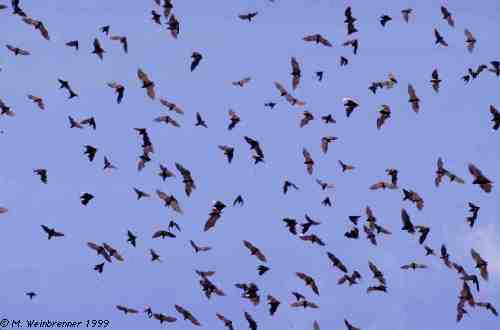
Straw-coloured fruit bats (Eidolon helvum)at Wli Waterfall
(Photo © M. Weinbrenner 1999)
Small Mammal Zoogeography
and Diversity in West African Forest Remnants
Progress Report to the
National
Geographic Society Committee for Research and Exploration (Grant 6583-99)
and the Ghana Wildlife
Division
by
Jan Decher1,
C. W. Kilpatrick1, and Kanton L. Bahian2
1 Univ. of Vermont,
Dept. of Biology, Marsh Life Science, Burlington, Vermont 05405-0086. USA0
2 Wildlife Division,
Kyabobo National Park, Nkwanta, Volta Region, Ghana
Abstract
We examine small mammal
(insectivore, bat, and rodent) diversity in traditionally protected sacred
groves and other forest remnants across a zoologically little known area
of West Africa, the Volta Region of Ghana. In the case of sacred groves,
most surveys have focussed on their botanical, ethnobotanical, or sociocultural
function. Previous research on the Accra Plains of Ghana indicated that
they are important as refuges for certain small mammal species. Many traditionally
protected forests are now threatened by population growth and by the gradual
loss of the traditional protecting mechanisms. Based on our findings, we
will recommend conservation guidelines for traditionally protected forests
and explore the involvement of local village communities in national wildlife
protection efforts, as in the proposed Kyabobo Range National Park. The
study should also generally improve our understanding of the distribution
of several mammal species in the Volta Region.
1. Introduction
In the last 300 to 400
years wildlife abundance and diversity in West Africa have declined on
a large scale. This decline has greatly accelerated during the last two
to three decades. The main reasons for this decline have been the widespread
loss of original habitat due to the promotion of species-poor monocultures
(cocoa, oil-palms, rubber trees), an increase of small private farms, and
growing hunting pressure, in combination with annual uncontrolled burning
of habitats. In Ghana, the only remains of original forest are found in
the patchwork of managed forest reserves established in the 1920's, in
the three high forest National Parks (Bia, Kakum, and Ankasa Conservation
Areas), and in the so-called "sacred groves" - traditionally protected
forest patches ranging in size from a few trees to several hundred hectares.
These groves are protected by religious taboos enforced by local villages.
Recent efforts to enumerate and assess the biodiversity of sacred groves
in Ghana and elsewhere have focussed mainly on botanical, ethnobotanical,
or sociocultural aspects (Amoako-Atta, 1995; Dorm-Adzobu et al., 1991;
Gadgil and Vartak, 1981; Gordon, 1992).
A previous study of small
mammal ecology and conservation on the Accra Plains in southern Ghana indicated
that sacred groves contain higher small mammal biomass than surrounding
areas and that they function as refuges to some small mammal species no
longer found anywhere else (Decher, 1997; Decher et al. 1997; Decher and
Bahian, 1999). The present study examines sacred groves and other forest
relicts in the Volta Region of Ghana with the following objectives:
1) Assess the diversity
and abundance of small mammal species (main emphasis will be on shrews,
bats, and rodents) in sacred groves and other forest remnants along the
Togo border in the Volta Region of Ghana.
2) Clarify the distributional
limits and systematic position of several genera and species in this region.
3) Provide Ghanaian
conservation officials and guardians of sacred groves with better ecological
data and conservation recommendations to continue to protect the remaining
forest sites for the future.
2. Materials and Methods
Shrew, bats, and rodents
are captured at several forest localities in the Volta Region (Click
here for map and sampling sites). Techniques used comply with recently
published standard methods for measuring and monitoring mammal diversity
(Wilson et al. 1996), guidelines approved by the American Society of Mammalogists
(Animal Care and Use Committee, 1998), and the Institutional Animal Care
and Use Committee (IACUC) of the University of Vermont. Voucher specimens
are being collected for the correct identification of species including
tissue samples for later molecular systematic analysis. We also collect
mammal ectoparasites. Voucher specimens are deposited at museum collections
based on the location of experts for the different taxonomic groups: a)
Insectivores, at the Museum Alexander Koenig, Bonn (R. Hutterer); b) Bats,
at the Senckenberg Museum, Frankfurt (D. Kock & J. Fahr); and c) Rodents,
at the University of Vermont, Burlington (J. Decher and W. Kilpatrick).
Synoptic reference collections will be prepared for the Wildlife Division
in Ghana and the University of Vermont, Department of Biology. Information
on some of the larger arboreal and diurnal species (squirrels, scaly-tailed
flying squirrels, primates, small carnivores) will be obtained by interviewing
local people and taking standardized early morning transect walks (Emmons,
1980) using high quality binoculars and a small portable digital video
camera. Notes on the microhabitat of each captured or observed animal will
be recorded on standardized habitat data sheets.
We photograph all live-trapped
species in preparation for an illustrated field guide and key to the mammals
of the Upper Guinea Region. Such a book is urgently needed as a teaching
tool and conservation reference for secondary school teachers, university
students, Wildlife Division staff, and other interested naturalists in
this region.
In the case of the traditionally
protected habitat a small questionnaire and informal discussions will be
used during the second field season to survey attitudes and intentions
of the local people toward their protected forest and the mammal species
present. All key participants involved, including local village representatives,
are be kept informed regarding the objectives and progress of this study
and will receive the final report and conservation recommendations.
Trapping effort during
the first field season was approximately the same for four sites visited
during the first field season. We used a total of 142 traps: 1 large and
100 standard Sherman live traps, 7 large and 2 smaller Tomahawk live traps,
20 Museum Special, and 12 Victor rat traps. We also employed lines of pitfall
traps using local plastic buckets and plastic drift fences in each habitat.
Bats are captured with standard mist nets set in forest flyways or across
small streams. Some new sites will be added in the second field season
and some previously sampled sites will be revisited for additional information.
4. First Results and
Discussion
4.1 Terrestrial Small
Mammals
Table 1 summarizes the
non-flying small mammal species found during the first field season. The
list includes a few species only observed and specimens brought to us by
local people from other unspecified localities nearby. Trapping success
ranged from 0 to 11.3%. The privately managed forest near the town of Apesokubi
was the most diverse site with seven species captured and with the highest
biomass - quite similar to sacred groves on the Accra Plains (Decher and
Bahian, 1999). There were no captures at Kyabobo Range National Park probably
because of the extremely dry conditions and previous forest fires (also
see comments under 4.3.4 below).
Initial identification
of terrestrial mammals was based on Rosevear (1996) and Meester and Setzer
(1971). The identification of Dephomys defua was based on Van der
Straeten (1984) and that of Malacomys edwardsi was based on comparisons
with measurements published by Van der Straeten and Verheyen (1979). The
Praomys
group may consist of more than one species and details remain to be resolved.
Shrews were identified by R. Hutterer at the Museum Alexander Koenig, Bonn
(in litt.).
Table 1: Non-volant
small mammal species verified in 4 different habitats in the Volta Region
of Ghana in December 1999.
| |
Location:
|
Kalakpa
|
Wli
|
Apesokubi
|
Kyabobo
|
| |
Source
of forest protection:
|
legal
|
legal
& traditional
|
traditional
|
legal
|
|
Scientific Name
|
Common Name
|
|
|
|
|
|
R o d e n t s
:
|
|
|
|
|
|
|
Praomys
sp.1
|
Soft-furred
mice
|
48
|
12
|
29
|
|
|
Malacomys edwardsi
|
Edward's swamp rat
|
|
|
3
|
|
|
Dephomys defua
|
Defua Mouse
|
|
|
1
|
|
|
Hylomyscus alleni
|
Allen's Wood Mouse
|
|
|
2
|
|
|
Lemniscomys striatus
|
Striped grass mouse
|
|
1
|
1
|
|
|
Graphiurus nagtglasii
|
African Dormouse
|
|
|
3
|
|
|
Mus musculoides3
|
Pygmy Mouse
|
1
|
1
|
|
|
|
Tatera kempi 3
|
Kemp's savanna gerbil
|
1
|
|
|
|
|
Anomalurus beecrofti4
|
Beecroft's scaly-tailed
flying squirrel
|
|
1
|
|
|
|
Paraxerus poensis2
|
Green Bush Squirrel
|
|
1
|
|
|
|
Xerus erythropus2
|
Striped ground squirrel
|
|
1
|
|
|
|
S h r e w s:
|
|
|
|
|
|
|
Crocidura cf.
douceti
|
Doucet'sMusk Shrew
|
|
|
1
|
|
|
Crocidura foxi
|
Fox's Musk shrew
|
|
|
2
|
|
|
P r i m a t e
s:
|
|
|
|
|
|
|
Galago or Galagoides
sp.2
|
Bushbaby
|
|
|
|
|
| |
Number
of Nights:
|
3
|
3
|
3
|
2
|
| |
Trapnights:
|
426
|
426
|
426
|
284
|
| |
Totals
captured:
|
50
|
14
|
42
|
0
|
| |
Trap
success:
|
11.7 %
|
3.3 %
|
9.9 %
|
0
|
| |
Total
biomass sampled:
|
1437.4 g
|
409.4 g
|
1737.7 g
|
0 g
|
1 Species probably
tullbergi
and
possibly one or two other species - taxonomy not currently resolved.
2 Observed,
or signs and local informants only.
3 Specimen
brought to us from nearby unspecified locality.
4 Specimen
brought to us by local hunter.
5 Biomass
= average weights of trapped species X number of individuals caught at
each site, for this field season
4.2 Bats
Mist nets for capturing
bats were set along or across paths or waterways inside the forest or at
the edge of the forest. At Apesokubi one net was also placed in a small
farm near our campsite. Initial identification of bats was based on Meester
and Setzer (1971) and Happold (1987). Final identification of bats was
provided by D. Kock and J. Fahr at the Senckenberg Museum, Frankfurt (in
litt.). To date 10 species of bats have been documented by this study (Table
2).
Table 2: Presence
of Bats verified in 4 different habitats in the Volta Region of
Ghana in December 1999.
| |
Location:
|
Kalakpa
|
Wli
|
Apesokubi
|
Kyabobo
|
| |
Source
of Forest Protection:
|
legal
|
legal
& traditional
|
traditional
|
legal
|
|
Scientific
Name
|
Common
Name
|
|
|
|
|
|
Epomops franqueti
|
Singing fruit bat
|
2
|
1
|
|
|
|
Epomophorus
gambianus
|
Epauletted
fruit bat
|
1
|
|
|
|
|
Micropteropus
pusillus
|
Dwarf epauletted
fruit bat
|
|
1
|
2
|
|
|
Nanonycteris veldkampi
|
Veldkamp's Dwarf
Fruit Bat
|
|
1
|
1
|
|
|
Eidolon helvum1
|
Straw-colored fruit
bat
|
|
1
|
|
|
|
Lissonycteris
angolensis smithi
|
Angola fruit bat
|
|
1
|
|
|
|
Rhinolophus alcyone
|
Halcyon horseshoe
bat
|
1
|
3
|
|
|
|
Rhinolophus landeri
|
Lander's horseshoe
bat
|
|
1
|
|
|
|
Hipposideros
ruber guineensis
|
Noack's
African leaf nose bat
|
|
2
|
1
|
|
|
Myotis bocagiicupreola
|
Rufous mouse-eared
bat
|
|
1
|
|
|
|
Totals
Captured:
|
4
|
12
|
4
|
|
|
Number
of Species:
|
3
|
9
|
3
|
|
1 Specimen brought
to us by local hunter.
4.3 Description of sites
visited during the first field season
4.3.1 Kalakpa
Resource Reserve
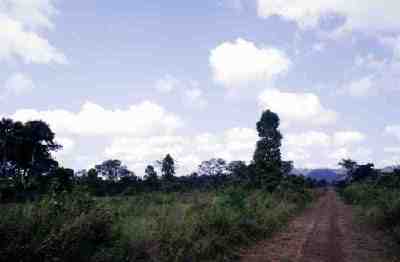
Plate 1: Roads and forest thickets
at Kalakpa Resource Reserve
Photo: © M. Weinbrenner 1999
Kalakpa Resource Reserve
is located in the southern Volta Region East of the Volta River and southeast
of the Abutia Hills Forest Reserve between 6°18' and 6°28' N and
0°17'and 0°30' E. The area consists of mostly tree savanna with
small thicket type forest remnants and gently undulating topography with
a few emerging hills rising to a maximum elevation of 422 m (Kadanga Hill).
Kalakpa Resources Reserve is still part of the so-called Dahomey Gap -
the break in the Upper Guinea forest belt with mostly savanna and lower
thicket-type forests, stretching from eastern Ghana to western Nigeria.
Thus this site forms the link to a previous study of small mammals in different
habitats on the Accra Plains west of the Volta River - the westernmost
extension of the Dahomey Gap (Decher and Bahian, 1999).
The trap site was located
at the northern edge of Kalakpa Resource Reserve near the Wildlife Division's
Zitoe Camp and the cut line of the park boundary (see Plate 1). It consisted
of a dense, low (10-15m tall) forest with many thickets of vines somewhat
similar to Pinkwae Forest on the Accra Plains, though somewhat lusher with
rich, dark soil and areas of waterlogging and intermittent small creeks.
The forest floor contained many burrows of land crabs.
Trapping was conducted
from 15 to 17 November 1999 and yielded 48 individuals of the rodent genus
Praomys
sp.
Bat netting yielded three species, the fruit bats Epomophorus gambianus
and Epomops franqueti (Megachiroptera), and the insect-eating bat
(Microchiroptera), Rhinolophus alcyone.
4.3.2 Wli Waterfall
(Agumatsa Wildlife Sanctuary)
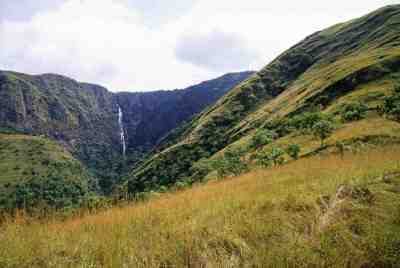
Plate 2: Wli Waterfall showing denuded
hill tops
Photo: © M. Weinbrenner 1999
This area was visited
from 18 to 23 November 1999. Wli Waterfall and the Agumatsa River valley
are located on the Ghana-Togo border at 7°06' N and 0°37' E. The
waterfall has been a tourist attraction for many decades and according
to Rice (1973) is also a "fertility fetish" site for the Wli traditional
area. Aside from the waterfall the main attraction of the area is the large
roost of several thousand straw-colored fruit bats (Eidolon helvum)
in the cliffs surrounding the waterfall. After being first surveyed
in 1973 (Rice, 1973) the area is now jointly managed by a local Wli Tourist
Management Team and the Ghana Wildlife Division. The area suffers from
clearcutting and uncontrolled burns on all slopes and hilltops (see Plate
2) and has experienced a stunning loss of forest since it was first seen
by the principal investigator in 1972. A small nursery started by
the Nature Conservation Research Centre (NCRC) in Accra supports reforestation
efforts. While working at Agumatsa Wildlife Sanctuary, we observed charcoal
burning, collecting of firewood, and small scale farming (maize and cassava)
within the sanctuary boundaries. The Wli waterfall remains a popular tourist
attraction but if long-term forest conservation efforts along the Agumatsa
River valley are to be successful in this sanctuary, protection efforts
and cooperation with local landowners need to be much improved.
So far our trapping efforts
at Wli resulted in one individual each of Praomys sp., Lemniscomys
striatus,and Mus minutoides. One scaly tailed flying squirrel
(Anomalurus beecrofti) was brought to us by a local hunter.
Dwarf bushbabies or galagos (Galagoides/Galago sp., Primates) were
observed with headlamps at night in the canopy near Agumatsa River. Bat
netting resulted in one individual each of the fruit bats Micropteropus
pusillus, Epomops franqueti, Epomophorus gambianus, Nanonycteris veldkampi,
Lissonycteris angolensis,and Eidolon helvum, the latter brought
to us by local hunter. The insect-eating suborder Microchiroptera
was represented by Rhinolophus alcyone,R. landeri, Hipposideros ruber,and
Myotis
bocagii.
4.3.3 Apesokubi
(Bedibem Forest)
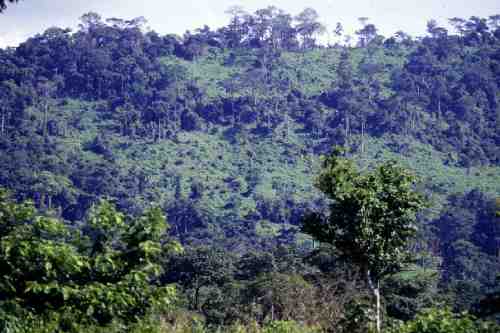
Plate 3: Forest Fragments at Apesokubi.
Photo: © M. Weinbrenner 1999
This site meets some of
the definitions of a traditionally protected site: it is locally maintained
and protected and not part of a forest or game reserve. Bedibem Forest
is located ca. 4.1 km north of the town of Apesokubi (7°37'N, 0°24'
E) adjacent to the Kabo River Forest Reserve. All forest outside
of the forest reserve in this area is highly fragmented (see Plate 3).
Bedibem is a small forest remnant privately owned by V. Aboagye and used
for trapping by his relative D. Aboagye, who was our guide.
Trapping results indicate
that this site is the most diverse site sampled so far. Seven species
of terrestrial small mammals and two species of bats were found present
during three days of trapping and netting. Small mammals found here and
not in any of the other sites were the rodents Hylomyscus alleni, Malacomys
edwardsi, Dephomys defua,and Graphiurus nagtglasii,and two species
of shrews, Crocidura foxi and C. cf. douceti. The
only bats caught here were Nanonycteris veldkampi, Micropteropus pusillus,and
Hipposideros
ruber guineensis.
4.3.4 Kyabobo Range
National Park
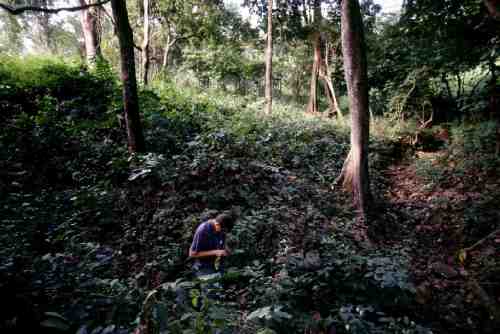
Plate 4: Trapping small mammals
at Kyabobo Range National Park
Photo: © M. Weinbrenner, 1999
Another legally protected
area sampled is the recently gazetted Kyabobo Range National Park (KRNP)
in the Northern Volta Region. It is located between approximately 8°17'
and 8°31'N latitude and 0°32' and 0°44'E longitude. The parks
eastern border is congruent in part with the Ghana-Togo border and the
Kue (Koué) River. To the northeast the KRNP is contiguous with the
Fazao-Malfakassa National Park in Togo. Both parks have an historically
interesting location overlapping in part with two "game
reserves" proposed in 1913 by the then German colonial administration,
which had identified this area as rich in game and worthy of protection
(Reichs-Kolonialamt, 1913). Due to time and logistic constraints
at the end of the first field season we trapped at KRNP for only 2 nights
in a dry and rocky "riparian and montane ravine forest" (see Plate 4) near
the town of Odome (8°20'N, 0°32'E). Trees in this forest
showed signs of burning and there was very little undergrowth. Trapping
success for the first field season at KRNP was zero. Additional sites within
KRNP will be visited during the second field season.
In 1994, a preliminary
study of the mammals of KRNP had been conducted by the Oxford University
Expedition to Ghana. They captured a total of 43 individuals composed
of 10 rodent and 2 shrew species in 11 plots and four vegetation types
throughout the park .
4.3.5 Shiare
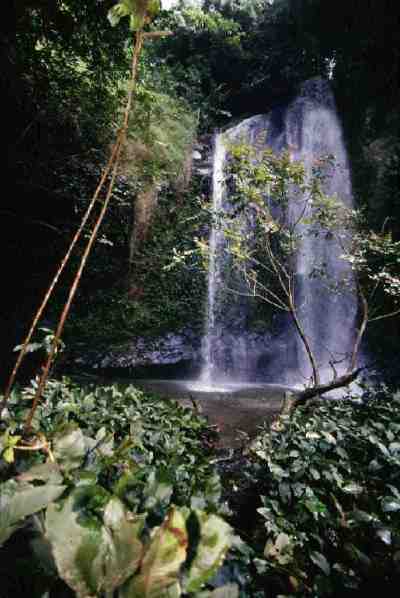
Plate 5: Forest and Waterfall
near Shiare
Photo: © M. Weinbrenner 1999
We located this future
study site on the last day in the Kyabobo area. Shiare is a remote mountain
village located at ca. 8°17'N and 0°37'E south of Kyabobo Range
National Park. On the
historical map Shiare can be placed halfway on a line between the towns
of Gokaron (=Gokoron) and Kjiringa (=Kyilinga) just north of Bismarckburg.
On another old German map Shiare is identified as "Tsiari" in the "Adjuti"
region (Karsch, 1893). Even today for the last kilometer Shiare,
is still only accessible on foot, located on a steep north-facing slope
and surrounded by moist semi-deciduous forest and lush secondary forest.
The valley is drained by Sabu Creek and its tributaries originating in
the hills around Shiare and entering the valley via several small waterfalls.
Shiare is one of eight villages of the Akyode tribe, a distinct Guan language
group in this area with a total of about 9000 people (Ledward and Bowes
Lyon, 1996). Initially the southern border of KRNP ran just north of Shiare
village but has recently been re-gazetted further north due to a conflict
with the villages of Shiare and Kyillinga regarding the loss of traditional
farm land through the creation of KRNP (Bahian and Hurst, 2000).
Already under German colonial rule the people of Shiare were known for
their independent spirit.
During our visit we had
a Meeting with
the elders in the town center of Shiare. Formalities included the pouring
of libation and the payment of an access fee to visit a waterfall behind
the village (see Plate 5). We discussed the possibility of a future survey
in the area and a cooperative effort to search for the enigmatic rodent
Leimacomys
(see section 4.4).
Given the recent increase
in number of visitors to their scenic valley, village representatives were
quite interested in some form of locally controlled ecotourism and how
such ecotourism could help generate some income for local community development
projects.
4.4 Search for the
Togo Mouse (Leimacomys buettneri Matschie, 1893)
Both the 1994 Oxford University
Expedition study and the present study attempted to rediscover the enigmatic
rodent species Leimacomys buettneri but so far without success.
Leimacomys
was first collected by R. Büttner or his local assistant in 1890 and
the locality given as Bismarckburg, which was the colonial district headquarter
located east of the modern town of Yegué, about 20 km east of KRNP
in Togo (08°15'N; 00°40'E). Only two specimens were preserved at
the Humboldt Museum in Berlin and were subsequently described as a new
species (Matschie, 1893) but they remain the only known specimens today.
Several studies have since linked Leimacomys with the subfamily
Dendromurinae and established that it feeds mostly on insects (Dieterlen,
1976; Denys, 1993; Misonne, 1966).
At Kyabobo Range National
Park Wildlife Division field staff, who were shown pictures
of these Leimacomys specimens, claimed they knew the species
but we did not yet succeed in obtaining additional specimens. Similarly
at Shiare, which is even closer to the original Togo locality, people seemed
to know this rodent from our description by the local name "Yefuli".
Attempts to obtain
Leimacomys in the hills near Shiare will include
further probing of the indigenous knowledge, various trapping methods,
and local participation to find this and other species. The dentition
and stomach contents point to a partially insectivorous diet the short
tail suggests a terrestrial life style (D. Kock, pers. comm.).
4.5. Definition of
"Traditionally protected forest"
The search for well-protected
sacred groves similar to the ones previously found on the Accra Plains
(Decher, 1997) and in other areas of Ghana (Yeboah, 1984; Dorm-Adzobu et
al., 1991) proved difficult in the Volta Region. Sacred groves known to
the Wildlife Society and the Wildlife Division in Accra, were described
to us as being highly degraded and thus unsuitable for our search for well-preserved
remnants of original forest. We propose to broaden our definition of traditionally
protected areas and not just include sacred groves sensu
strictu but also privately managed forest like the one sampled at Apesokubi
and the community-protected forest at Wli Waterfall.
The village of Shiare
includes several sacred shrines off limits to visitors and a still relatively
undisturbed relationship of the local Akyode people with the surrounding
natural environment. This area may thus fit the definition of a sacred
landscape as proposed by P. S. Ramakrishnan who wrote (1996):
"Conserving
a 'sacred landscape' will be a challenge because of the diversity in types
of ecosystems interconnected with different human activities and concerns.
. . sustainable development can only involve a series of compromises, which
should not be based on biophysical considerations alone but on striving
to integrate human dimensions into a holistic view of 'ecology' in its
most all-encompassing sense [...] The sustainable development of the region
must be treated as inextricably bound up with local manifestations of 'vernacular
conservation'. Declaring these sacred landscapes as 'national heritage
sites' would not only be a step in the right direction for conservation
[...] but also for the evolution and implementation of culturally sensitive
action plans for sustainable development, endorsed and supported by the
empathy and wholehearted participation of the local population."
(Ramakrishnan, 1996:18).
How such a view of local
conservation could be realized in Shiare will be explored during the second
field season in discussions with village representatives and with other
conservation organizations working in the area, such as the Nature Conservation
Resource Centre (NCRC).
5. Local Cooperation
and Follow-up
Local cooperation and
enthusiasm were excellent at all sites visited. Copies of The
Kingdon Field Guide to African Mammals were donated to representatives
from Kalakpa Resource Reserve, Agumatsa Wildlife Sanctuary, Shiare Village
and the Forestry Division. The principal investigator is currently organizing
some textbook donations and shipment of books to the towns of Apesokubi
and Shiare to help alleviate the great demand for educational materials
in local schools, especially in the area of natural history and conservation.
6. Special Problems
and Challenges during the 1999 Field Season
The first field season
and the completion of the objectives were hampered by two unforeseen challenges.
The principal investigator (J. Decher) lost valuable field time for location
scouting during the first week, due to a severe medical reaction to the
malaria prophylaxis (Lariam-Mefloquine) causing a 3-day delay in his departure
to Ghana from Boston, Massachusetts.
At the end of the first
week in Ghana (12 November 1999) all optical research equipment of the
principal investigator was stolen from the field vehicle in Accra, which
made the proposed observation and video recording of larger arboreal and
diurnal mammal species impossible. Both elements of this study still need
to be addressed in a second field season.
7. Proposed Continuation
of Work
A second field season
is proposed for August 2001. This field season will focus on surveying
small mammals at additional sites throughout Kyabobo Range National Park
and the area around Shiare village, including a concerted effort to find
Leimacomys
buettneri. An invitation from Shiare has already been received (Mr.
E. B. Ogah, in litt.). Return visits to some of the other sites are planned
to complete observational work and a survey of local knowledge and conservation
perspectives.
Plans are also being discussed
to add a reptile and amphibian component (Dr. M.-O. Roedel, Würzburg,
Germany) and to begin work on an illustrated field guide to the mammals
of the Upper Guinea forest block.
Acknowledgements
We acknowledge the
support and cooperation of the following individuals and organizations
during the 1999 field season:
Ghana
N. K. Ankudeh, Mr Ofori-Frimpong,
Mike Adu Nsiah of the Ghana Wildlife Division, Accra.
Wildlife Officer P. Darkwa
and his staff S. Y. Ampeh, H. Meliba, E. Agordzo at Kalakpa Resource Reserve.
E. Gblokpor. E. Mawinya
and Wildlife Division staff and A. Adibi and A. Kipo at Wli Waterfall.
Wildlife
Division staff at Kyabobo Range National Park.
A. S. K. Boachie-Dapaah
and F. Koomson of the Forest Services Division in Accra and Jasikan
Larseh Ashrifie and John
Mason of the Nature Conservation
Research Centre (NCRC) in Accra
Mr Michael P. K. Ahwireng
and his family at Apesokubi.
D. Aboagye and E. Tawia
for assistance in locating and working at Bedibem forest, Apesokubi.
Mr. E. B. Ogah and the
elders and people of Shiare.
Germany
D. Kock and J. Fahr,
Senckenberg
Museum, Frankfurt.
R. Hutterer at the Museum
Alexander Koenig, Bonn.
M.
Weinbrenner, Photojournalist, Essen - Photography and field assistance.
USA
John Echave of the National
Geographic Society - additional slide film and processing.
T. Tailer of Essex, Vermont
- technical support
The D. Mills family in
Boston, Massachusetts - hospitality during J. Decher's medical delay.
This study is made
possible through Grants #6583-99 and 6900-00 from the
National
Geographic Committee for Research and Exploration.
Literature Cited
Amoako-Atta, B. 1995. Sacred
groves in Ghana. Pp. 80-95, in Cultural landscapes of universal
value: components of a global strategy (B. von Droste, H. Plachter
and M. Rössler, eds.). Gustav Fischer Verlag Jena, Stuttgart,
:464 pp.
Animal Care and Use Committee.
1998. Guidelines for the capture, handling, and care of mammals as
approved by The American Society of Mammalogists. Journal of Mammalogy,
79:1416-1431.
Bahian, K. L., and J. Hurst. 2000.
Final boundary for Kyabobo Range National Park. Gikelan - the newsletter
of the Kyabobo Conservation Project, 1.
Decher, J. 1997. Conservation,
small mammals, and the future of sacred groves in West Africa. Biodiversity
and Conservation, 6:1007-1026.
Decher, J., and L. K. Bahian.
1999. Diversity and structure of terrestrial small mammal communities
in different vegetation types on the Accra Plains of Ghana. Journal
of Zoology, London, 247:395-407.
Decher, J., D. A. Schlitter, and R.
Hutterer. 1997. Noteworthy records of small mammals from Ghana
with special emphasis on the Accra Plains. Annals of Carnegie Museum,
66:209-227.
Denys, C. 1993. Réexamen
de la dentition de Leimacomys buettneri (Mammalia, Rodentia). Hypothèses
sur sa position systematique. Mammalia, 57:613-618.
Dieterlen, F. 1976. Bemerkungen
über Leimacomys büttneri Matschie, 1893 (Dendromurinae,
Cricetidae, Rodentia). Säugetierkundliche Mitteilungen, 24:224-228.
Dorm-Adzobu, C., O. Ampadu-Agyei, and
P. G. Veit. 1991. Religious beliefs and environmental protection:
The Malshegu Sacred Grove in Northern Ghana. 4. World Resources Institute,
and Nairobi, Kenya: Acts Press, Washington, D. C., vii + 35 pp.
Emmons, L. H. 1980. Ecology
and resource partitioning among nine species of African rain forest squirrels.
Ecological Monographs, 50:31-54.
Gadgil, M., and V. D. Vartak.
1981. Sacred groves of Maharashtra: an inventory. Pp. 279-294,
in Glimpses of Indian Ethnobotany (S. K. Jain, ed. Oxford
and IBH Publishing Company, New Delhi, :xvi + 365 pp.
Gordon, C. 1992. Sacred
groves and conservation in Ghana. Newsletter of the IUCN SSC African
Reptile & Amphibian Specialist Group, 1:3-4.
Happold, D. C. D. 1987.
The mammals of Nigeria. Clarendon Press, Oxford, xvii + 402 pp.
Hurst, J., D. Bowes Lyon, and E. O'Keefe.
1995. Kyabobo '94: a joint Ghanaian and Oxford University Expedition.
Final Report. KCP Publications, Ghana Wildlife Department, Institute for
Renewable Natural Resources, 69 pp.
Karsch, F. 1893. Die Insekten
der Berglandschaft Adeli in Hinterlande von Togo (Westafrika). Berliner
entomologische Zeitschrift, 38:1-266.
Ledward, A., and D. Bowes Lyon.
1996. The relationship between the Akyode people and their local
environment - a study in the Northern Volta Region, Ghana. Kyabobo Report
Series. No. 2, 93 pp. Kyabobo Conservation Project and Wildlife Department,
Kyabobo Range National Park
Matschie, P. 1893. Über
anscheinend neue afrikanische Säugethiere (Leimacomys n. g.).
Sitzungsbericht der Gesellschaft der naturwissenschaftlichen Freunde, Berlin,
4:107-114.
Meester, J., and H. W. Setzer.
1971. The mammals of Africa. An identification manual. Smithsonian
Institution Press, Washington, vii + 15 parts pp..
Misonne, X. 1966. The systematic
position of Mystromys longicaudatus Noack and of Leimacomys büttneri
Matschie. Annales du Musee Royale de l'Afrique centrale, Sciences
Zoologiques, 144:41-45.
Ramakrishnan, P. S. 1996.
Conserving the sacred: from species to landscape. Nature & Resources,
32:11-19.
Reichs-Kolonialamt. 1913.
Jagd und Wildschutz in den Deutschen Kolonien. 5. Verlag von Gustav Fischer,
Jena, pp.
Rice, K. W. 1973. A faunal
survey of Agumatsa Waterfall area, Volta Region. Ghana Department of Game
and Wildlife, unpubl. Report.
Rosevear, D. R. 1969. The
rodents of West Africa. British Museum of Natural History, London,
xii + 604 pp.
Van der Straeten, E. 1984.
Etude biometrique des genres Dephomys et Stochomys avec quelques
notes taxonomiques (Mammalia, Muridae). Revue Zoologie Africaine,
98:771-798.
Van der Straeten, E., and W. N. Verheyen.
1979. Notes taxonomiques sur les Malacomys de l'Ouest africain
avec redescription du patron chromosomique de Malacomys edwardsi (Mammalia,
Muridae). Revue Zoologie Africaine, 93:10-35.
Wilson, D. E., F. R. Cole, J. D. Nichols,
R. Rudran, and M. S. Foster. 1996. Measuring and monitoring
biological diversity. Standard methods for mammals. Smithsonian Institution
Press, Washington, xxvii + 409 pp.
Yeboah, S. 1984. Small rodent
ecology in two contrasting habitats: primary forest and farmland
in eastern Ghana. Doctoral Dissertation, University of Aberdeen,
222 pp.
© Jan Decher 2001.
Document last updated: 12 June 2001.